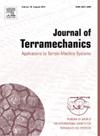The deep sea polymetallic nodule mining vehicle maneuverability depends on the vehicle track parameters and track configuration. The traction force offered by the deep sea soil is very limited for the mining vehicle during dynamic operating conditions on the seabed and it is very critical to maneuver against the external resistances. The present study strives to arrive at optimum track parameters for enhancing the traction of the vehicle for the pre-determined seabed conditions. The efficacy of the four tracks in Inline and Offset track configurations on the soft soil has been compared. To improve the traction force estimation, the existing mathematical model was modified with the inclusion of dynamic variation of shear stress-shear displacement characteristics and variation in shear residual displacement concerning the track parameters. The modified mathematical model was solved in a well-established mathematical tool and found that there are 30 percent improvements in the traction force generation for the offset configuration over inline track configuration. The optimum track length to width ratio () was also estimated for the given contact area to configure the vehicle track for improvement of the traction. Further, a Multi-Body Dynamic (MBD) analysis has been carried out in commercially available soil-machine interaction tool for the inline and offset track configurations with actual measured seabed soil parameters. The MBD analysis proved that the sinkage and vehicle gradient is significantly increased in the inline track configuration due to disturbance created by the front tracks. The simulation results confirm that the offset track configuration is suitable for the deep sea soil conditions for handling the higher payload of a deep sea mining vehicle.


